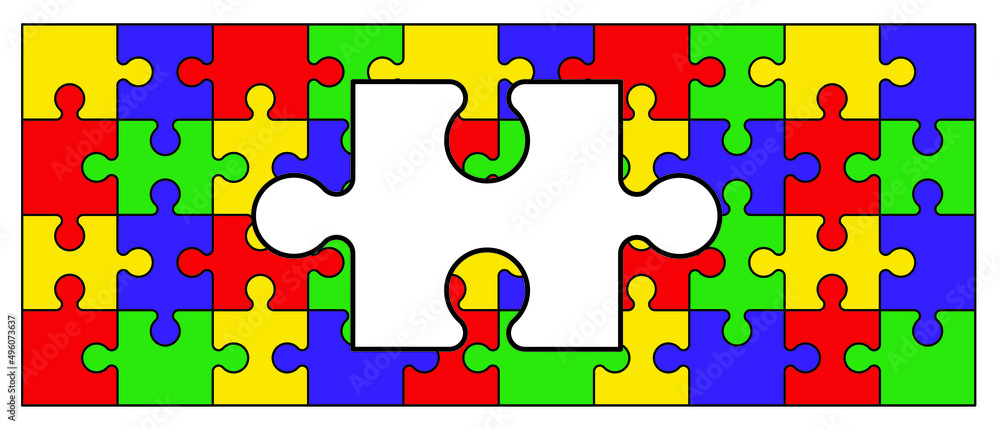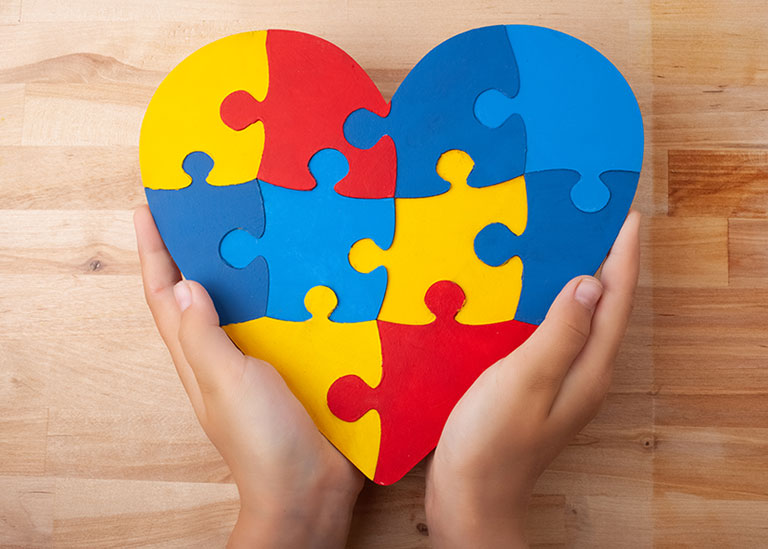Have you ever noticed the colorful puzzle piece symbol associated with Autism Spectrum Disorder (ASD) and wondered what it truly signifies? This intriguing icon isn’t just a random choice; it holds a deep meaning that resonates with many.
As you dive into the world of autism, understanding this emblem can transform your perspective. It’s more than just an image—it’s a representation of diversity, complexity, and the unique beauty that comes with being different. You’ll discover how this puzzle piece connects to the experiences of countless individuals and families, perhaps even your own.
Curious to explore its history and significance? Stay with us, and uncover the story behind the symbol that speaks volumes about embracing differences and fostering acceptance.
Origins Of The Puzzle Piece Symbol
The puzzle piece symbol is widely associated with Autism Spectrum Disorder (ASD). It signifies complexity and diversity within the autism community. Its origins date back several decades, reflecting both historical adoption and ongoing debate.
History And Adoption
The puzzle piece was first used by the National Autistic Society in 1963. It aimed to represent the mystery and complexity of autism. The symbol quickly gained traction, becoming a universal emblem for autism awareness. Organizations worldwide adopted it, recognizing its compelling representation of the autism puzzle.
Its simple design made it memorable. People connected with its visual message. The puzzle piece became a beacon for autism campaigns, helping spread awareness. It stood as a reminder of the challenges and uniqueness of individuals with autism.
Controversy And Criticism
Despite its widespread use, the puzzle piece symbol faces criticism. Some argue it suggests that autistic individuals are incomplete or missing pieces. This perspective sees the symbol as negative, implying a need to solve autism.
Critics propose alternatives that celebrate diversity instead. They advocate for symbols that represent acceptance and understanding. The debate continues, with many seeking a symbol that resonates more positively. Discussions highlight the need for symbols that truly reflect the autistic community’s strengths.

Credit: en.m.wikipedia.org
Understanding Autism Spectrum Disorder
The Autism Spectrum Disorder puzzle piece symbolizes the complexity and diversity within the autism community. It reflects the unique characteristics and challenges faced by individuals with autism. Understanding this symbol can foster empathy and awareness.
Understanding Autism Spectrum Disorder is crucial for creating a more inclusive world. Autism affects millions, yet many still struggle to comprehend its nuances. By learning about its definition, characteristics, prevalence, and statistics, you can become a more informed and empathetic individual. ###
Definition And Characteristics
Autism Spectrum Disorder (ASD) is a developmental condition that affects how a person communicates and interacts with others. People with autism often experience challenges in social communication, have repetitive behaviors, and may have unique strengths or differences. Some individuals might excel in specific areas like math or music, while others may need support in daily tasks. Children with autism might find it difficult to engage in typical play activities. Adults with autism may struggle in social settings, preferring routines that provide a sense of security. It’s important to remember that autism is a spectrum, meaning it affects each person differently. ###
Prevalence And Statistics
Autism affects approximately 1 in 54 children in the United States, according to recent studies. This number has increased over the years, partly due to better awareness and diagnostic methods. It’s a reminder of the importance of understanding and supporting those on the spectrum. Interestingly, boys are four times more likely to be diagnosed with autism than girls. However, this statistic has sparked discussions on whether girls are underdiagnosed due to different socialization patterns. Understanding these statistics helps in advocating for early intervention and appropriate resources. Are you surprised by these numbers? They highlight the need for more awareness and support in educational and social settings. By learning about autism’s prevalence, you can contribute to a more supportive environment for those affected.
Significance Of The Puzzle Piece
The puzzle piece symbolizes Autism Spectrum Disorder, highlighting its complex and diverse nature. It represents the individuality of people with autism and the challenges they face. This emblem encourages awareness and acceptance, fostering understanding and support within communities.
The puzzle piece is a widely recognized symbol of Autism Spectrum Disorder (ASD). Its vibrant colors and interlocking shapes represent the diversity within the autism community. This symbol has sparked discussions and debates. It holds a significant place in raising awareness and advocating for acceptance.
Symbolism And Representation
The puzzle piece represents complexity and uniqueness. Each piece is different, just like individuals with autism. It shows that autism is varied and multifaceted. The interlocking pieces symbolize unity and connection. They highlight the importance of community support. Some view the puzzle piece as incomplete. This can imply that individuals with autism need fixing. Critics argue for symbols that emphasize acceptance and positivity. Despite differing opinions, the puzzle piece remains a strong image. It helps in creating dialogue about autism.
Impact On Awareness And Advocacy
The puzzle piece boosts awareness. It draws attention to autism and its challenges. Organizations use it in campaigns and events. This increases public knowledge and understanding. Advocacy groups have adopted the puzzle piece. They use it to promote inclusion and acceptance. It has become a rallying point for change. These efforts lead to better resources and support for those affected. The symbol is key in driving meaningful conversations. It encourages society to embrace neurodiversity. The puzzle piece continues to be a powerful tool. It shapes perceptions and fosters greater acceptance.

Credit: stock.adobe.com
Alternative Symbols And Representations
Autism Spectrum Disorder (ASD) discussions often include symbols and representations. The puzzle piece has been a dominant symbol for many years. Yet, there is a growing call for alternative symbols. People seek imagery that better represents the diversity within the autism community.
Emergence Of New Symbols
Many in the autism community prefer symbols that convey acceptance. The infinity loop, with its vibrant colors, is gaining popularity. It symbolizes endless possibilities and the spectrum of autism. This symbol reflects the diverse experiences of individuals with ASD. Many find it more inclusive and less stigmatizing than the puzzle piece.
Another emerging symbol is the butterfly. It represents change and growth. It captures the essence of transformation and beauty. People appreciate its positive and hopeful connotations. These symbols are slowly making their way into mainstream awareness.
Debates And Discussions
The shift from the puzzle piece sparks lively debates. Some argue the puzzle piece suggests incompleteness or mystery. This can perpetuate stereotypes about autism. Others feel it is a long-standing symbol with historical significance.
Discussions often focus on the need for respectful representation. Many believe that symbols should be chosen by those with lived experiences. This ensures that the imagery resonates with the community’s values. The conversation around symbols is ongoing and evolving.
These debates highlight the importance of inclusive representation. They encourage a more nuanced understanding of autism. As symbols evolve, they foster greater acceptance and awareness.
Community Perspectives
Community perspectives on Autism Spectrum Disorder focus on the puzzle piece symbol. This symbol represents the complexity and diversity of autism. Many view it as a way to raise awareness and understanding.
Autism Spectrum Disorder (ASD) is often represented by a puzzle piece symbol, signifying the complexity and diversity of the autistic community. Understanding this symbol from various perspectives within the community is crucial. You’ll find that the puzzle piece evokes different emotions and thoughts among autistic individuals, their families, and caregivers. Let’s delve into these community perspectives.
Voices Of Autistic Individuals
Autistic individuals have varied opinions about the puzzle piece symbol. Some feel it represents the uniqueness and individuality of every autistic person. Others view it as a reminder of being ‘different’ or ‘missing something,’ which can be hurtful. Have you ever considered how symbols you encounter daily might impact your self-perception? Personal stories highlight the desire for symbols that promote acceptance and understanding rather than focus on ‘fitting in.’ What symbols resonate with you?
Families And Caregivers
Families and caregivers often see the puzzle piece as a bridge to raising awareness. They use it to spark conversations and educate others about autism. Yet, some families prefer symbols that emphasize acceptance and support. They want their loved ones to be seen for their strengths rather than their differences. Consider how symbols in your life shape your understanding of community and belonging. Have you ever shifted your perspective based on feedback from your community? Engaging with these diverse perspectives reminds us that symbols hold significant power. How might you contribute to evolving these symbols to better reflect acceptance and understanding?
Future Directions In Autism Symbolism
Exploring new meanings in autism symbolism, the puzzle piece sparks diverse conversations. It represents complexity and individuality, urging deeper understanding. This familiar symbol continues to inspire fresh perspectives within the autism community.
In recent years, the symbolism of Autism Spectrum Disorder has been evolving. The puzzle piece, once a dominant symbol, faces new interpretations. Society now seeks symbols that better reflect understanding and acceptance. This search aims to capture the diversity within the autism community. Shifting narratives offer hope for more inclusive representation.
Evolving Narratives
The puzzle piece has long been associated with autism. Critics argue it suggests that autistic individuals are incomplete or need fixing. This perception can be harmful and limiting. Many advocate for symbols that embrace neurodiversity instead. Symbols that celebrate differences and highlight strengths. The push for change comes from within the community itself. Families, advocates, and autistic individuals voice their desires. They seek symbols that truly represent their experiences and identities.
Potential For Change
Change in autism symbolism could lead to broader societal shifts. New symbols might foster better understanding and acceptance. Society could embrace a more inclusive perspective. This shift encourages awareness of the unique contributions of autistic individuals. Symbols hold power in shaping perceptions and narratives. The choice of symbol impacts how autism is viewed by the world. The future of autism symbolism remains open to possibilities. New symbols could emerge that align with the values of inclusivity and respect. This evolution in symbolism invites dialogue and reflection. Society stands at a crossroads in how autism is represented.

Credit: www.childbrain.com
Frequently Asked Questions
What Does Puzzle Piece Mean In Autism?
The puzzle piece symbolizes autism and represents complexity and diversity. It signifies the uniqueness of each individual with autism. Some people find it controversial, associating it with the idea that individuals with autism need to be “fixed. ” Alternatives like the infinity symbol are gaining popularity for promoting acceptance and inclusion.
Why Do People With Autism Like Puzzles?
People with autism often enjoy puzzles due to their structured nature. Puzzles provide a calming, focused activity, enhancing problem-solving skills and concentration. Engaging in puzzles can also offer a sense of accomplishment and reduce anxiety. This interest in puzzles varies among individuals with autism.
Is The Autism Infinity Symbol Controversial?
The autism infinity symbol can be controversial for some. Critics argue it lacks historical significance compared to the puzzle piece. Supporters appreciate its representation of diversity and limitless potential in autism. Preferences vary widely, reflecting personal views and experiences.
What Is The Alternative To The Autism Puzzle Piece?
The infinity loop symbol is an alternative to the autism puzzle piece. It represents diversity and inclusion. The rainbow colors in the loop emphasize neurodiversity. Many advocates prefer it for its positive and inclusive message.
Conclusion
Understanding Autism Spectrum Disorder helps build a more inclusive world. Small steps matter. Each puzzle piece represents a part of a larger picture. Awareness leads to acceptance and support. Everyone deserves respect and empathy. Embrace the diversity that autism brings.
Learn, listen, and engage with kindness. Conversations and education create positive change. Challenge misconceptions and stereotypes. Together, we can create a supportive community. Every effort counts in making a difference. Celebrate uniqueness and individuality. Encourage understanding and compassion. Keep learning and growing in awareness.
Autism is a journey, not a label. Let’s walk this path together.
